The following photo is from the early 1980s and shows part of a terrace of houses. The house on the left with the pediment has a plaque stating “New Terrace – 1791”. The location is in Islington, a short distance south east of Islington Green. New Terrace, now Duncan Terrace is separated from Colebrooke Row by a strip of grass which has an interesting history.
This is the same view almost 40 years later. The perspective is not exactly the same as the trees in front of the house with the pediment have grown significantly and obscure the pediment and plaque when looking from the original viewpoint.
Many of the terraces in this part of Islington were in a poor state in the early 1980s, but the decade would bring a transformation to the area. New Terrace at the time seemed to have escaped the problems suffered by many other terraces and was in good condition as the terrace approached the age of 200 years.
The location of New Terrace is shown in the following map extract. To the south east of Islington Green, the terrace is the upper row of houses in the red oval, north of Charlton Place (Map © OpenStreetMap contributors).
The houses in this area have a complex history, with piecemeal construction starting in the 18th century. Originally, the land was comprised of agricultural fields, clay pits and nursery gardens.
In 1613, the New River was constructed, and the route can still be traced today by the grass strip that runs from New Terrace all the way down to City Road. In the above map, the green strip shows the grass and public park between Duncan Terrace and Colebrooke Row, the grass strip running further north in front of New Terrace is not shown on the map, but is indicated by the gap between the terrace and Colebrooke Row.
Duncan Terrace is named after Admiral Duncan the commander of the Naval Fleet at the Battle of Camperdown against the Dutch in 1797.
Colebrooke Row is named after Sir George Colebrooke who developed the Colebrooke Row side of the street.
New Terrace was built in 1791 by James Taylor, a young surveyor and builder. The terrace has gone through a number of name changes from New Terrace to Colebrooke Terrace, to Duncan Terrace, the name which remains to this day.
The grass strip running in front of the terrace was the route of the New River. The river was enclosed in a pipe in 1861 which was covered and planted. The pipe was out of use by 1950 and was then removed leaving the grass strip as a reminder of the early history of London’s water supply.
Looking north along the original route of the New River:
The view to the south showing how the terrace was built at a raised level to the river:
As the terrace could not face directly onto the New River, a raised pavement was built in front of the terrace, and this remains today to give access to the front doors of each house:
In 1793, Taylor continued the southern extension of the terrace and built what are now numbers 46 to 49 Duncan Terrace on the opposite side of the junction with Charlton Crescent. This area was originally known as Clay Pit Field as it had been occupied by clay pits, extracting clay for the manufacture of bricks, but as the clay was exhausted, the land was more valuable as a site for houses.
This southern terrace followed a similar design to the northern New Terrace with a raised pavement between the houses and the New River:
Further south along Duncan Terrace is the rather magnificent church of St John the Evangelist, built as a result of the Catholic Emancipation Act of 1829 which released Catholics from the restrictions that had been imposed on them since the Reformation.
The land was purchased for the church in 1839, and the design completed by the Catholic architect Joseph John Scoles. It took a number of decades for the church to be completed with work on the towers commencing in 1873.
The terraces either side of the church are today in lovely condition, but as with much of Islington this is a result of restoration work over the last few decades and the considerable increase in value of properties in the area.
In 1953, the route of the New River had not yet been landscaped, or turned into a park, as shown in the following photo from 1953, and there was a gap in the terrace where one of the houses had suffered bomb damage.
Image credit: London Metropolitan Archives, City of London: catalogue ref: SC_PHL_01_182_53_19
Crossing the route of the New River and into Colebrook Row and the street is lined with similar terraces:
And this is where the Regents Canal enters the Islington Tunnel – this is the view looking along the canal on approach to the tunnel:
The entrance to the Islington Tunnel, under Colebrooke Row. The tunnel runs to Caledonian Road and is 878 meters long.
Walking back along Colebrooke Row, and the park follows the route of the New River and separates Colebrooke Row and Duncan Terrace. They are now landscaped, planted with trees, with a central path running the length of the park:
Although today there is a one way system running through the parks, with the appropriate warning signs about social distancing:
The following photo shows the eastern side of Colebrook Row, with the street, then the New River route on the left, then Duncan / New Terrace (on the left but not visible in the photo). As can be seen from the slight differences in architectural styles, the terrace has changed over time. as different builders added to, demolished parts of, and changed the style of the buildings.
I have walked from New Terrace at the top of the oval in the map, to the Regents Canal at the lower end of the oval, and back again along Colebrooke Row, as there is one house to find that is earlier than all the other houses, and was once the home of a rather interesting character.
The white painted house at the end of the terrace in the following photograph is Colebrooke Cottage, number 64 Duncan Terrace, dating from around 1760.
Colebrooke Cottage was originally a single house, standing alone in the fields that covered the area, and faced onto the New River. It remained a single house until the construction of New / Duncan Terrace on the left. The following photo shows Colebrooke Cottage, New / Duncan Terrace to the left and the route of the New River running between terrace and road.
The following print shows Colebrooke Cottage as it was before the construction of New Terrace. It is rather idyllic view. The cottage is surrounded by trees, the New River runs along the front and a boy is fishing in the river © The Trustees of the British Museum.
Comparing the two prints shows a number of differences mainly down to 19th century changes, including a reduction in the number of windows. Restoration work in the 1970s uncovered evidence of the side windows that would have had to have been bricked up when New Terrace was built.
The print is titled Charles Lamb’s House At Islington.
Charles Lamb was a poet and essayist. Born in Office Row in the Temple in 1775 where his father worked in the legal profession. On the death of his father’s employer, the family consisting of Charles, his sister Mary and their mother and father had to leave the house tied with his father’s job and move into cramped lodgings nearby.
After a short spell at the South Sea Company, he moved to the East India Company in 1792, where he would spend the rest of his working life. He was employed as a clerk, a job he did not enjoy.
His first published work was a small collection of sonnets that he provided for a book of poems published by Coleridge in 1796.
But it was not until the 1820s that he achieved a degree of fame when he published a series of essays in the London Magazine under the name of Elia (a name he adopted, allegedly the last name of an Italian man that had also worked at the South Sea Company)
However in many ways he had quite a tragic life which probably influenced his writing.
After the death of his father’s employer, the family were forced to move to cramped lodgings, and Charles and his sister Mary seem to have been responsible for supporting the family, and it was the resulting pressure which probably led to his sister Mary, in a fit of insanity to kill their mother and badly wound their father.
Charles took Mary to an asylum, and to avoid her imprisonment, he agreed to look after her at home, which he did for the rest of his life.
Mary did suffer mental health problems for the rest of her life, but she also published works with Charles, including a retelling of Shakespeare for children, a book which is still published today.
He did not marry. His first proposal of marriage to one Ann Simmons was rejected which led to a short period of what at the time was called insanity, probably what we would now call depression.
His second attempt at marriage, with a proposal to an actress Fanny Kelly was rejected, probably because she could not contemplate a life which involved looking after Mary.
He moved to Colebrooke Cottage in 1823 and stayed there for only 4 years, but it was here that he was the happiest he had ever been. He retired from work at the East India Company, and lived here with Mary, surrounded by books and the Islington countryside, and entertained literary friends. He described leaving his job as “33 years’ slavery…a freed man, with £441 a year for the remainder of my life”.
He described the house as a cottage, “for it is detached, with six good rooms. The New River runs close to the foot of the house and a spacious garden is behind. I feel like a great lord, never having had a house before”.
However the writer Thomas Hood called it a “cottage of ungentility for it had neither double coach house nor wings, and like its tenant, it stood alone”. Some author snobbery or competition perhaps.
The New River caused occasional problems for his guests as the myopic writer George Dyer fell into the river after leaving the house.
In 1827 he left Islington and moved to Enfield, followed by a move to Edmonton in 1833, where he died the following year after a fall.
A print of Charles Lamb dating from 1828 © The Trustees of the British Museum:
A London County Council plaque is on the front of Colebrooke Cottage to commemorate Charles Lamb’s time on Colebrooke Row, Islington.
Walking along Colebrooke Row, there is not really anything that would stand out – it’s a street of rather nice late 18th / early 19th century terrace houses as can be found across much of Islington. I went there to find the location of one of our 1980s photos. However, what makes this street so special is a single house that remains from the time when this was all agricultural land and clay pits. Finding one of the few places where the route of the New River can still be clearly seen, and how houses were built to face on to the New River.
And finding a literary character who was in the shadows of the major literary characters of the time, who should have had a happier life, but who seems to have enjoyed a few years surrounded by the Islington countryside.

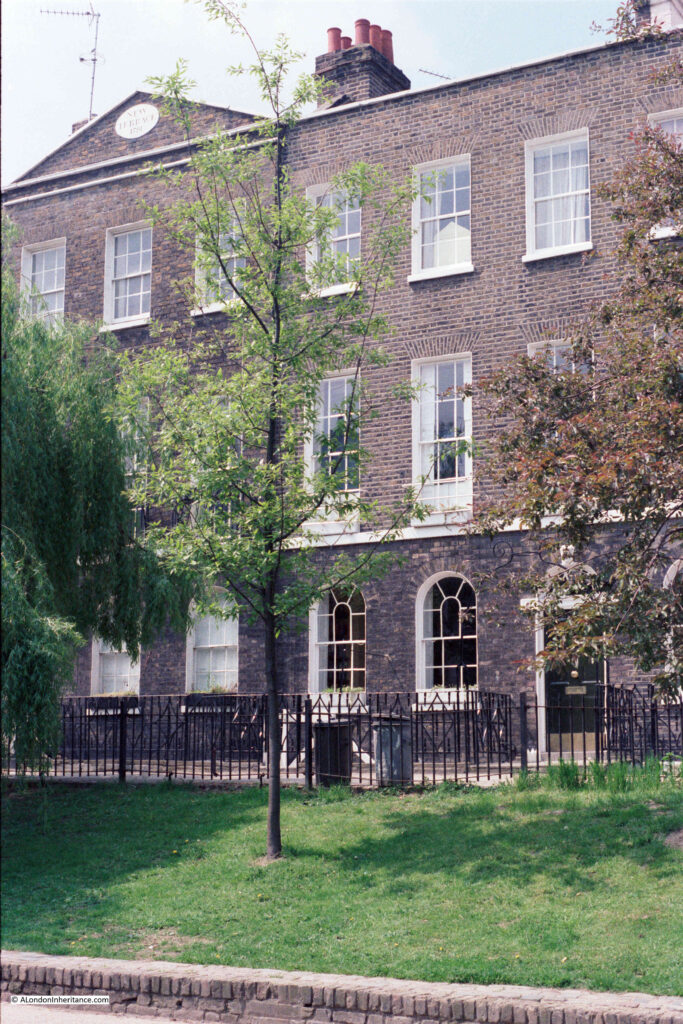
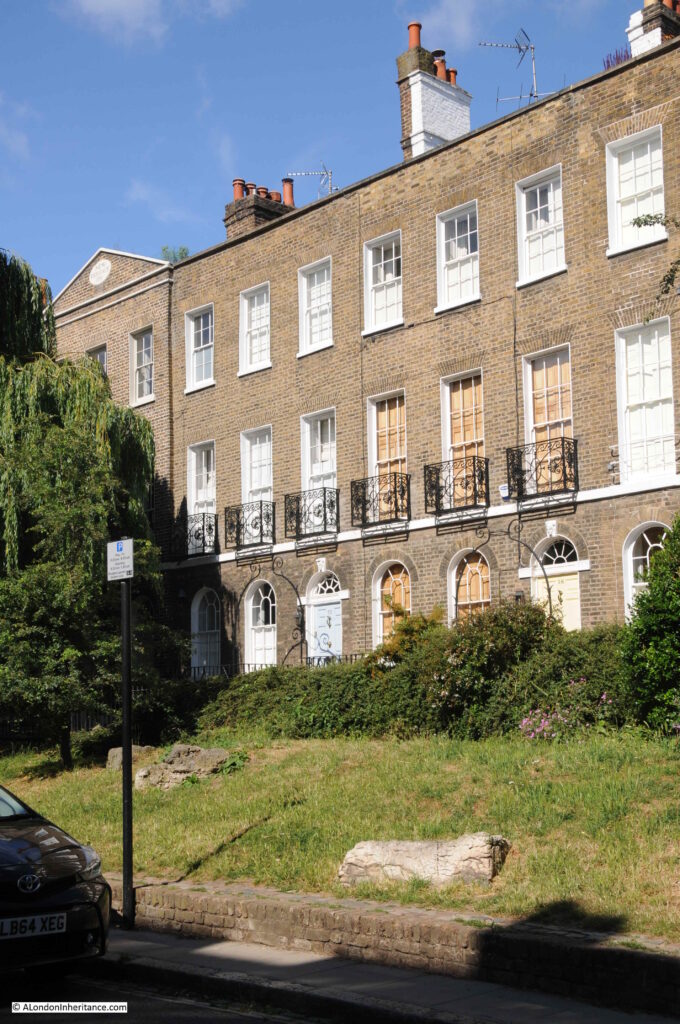

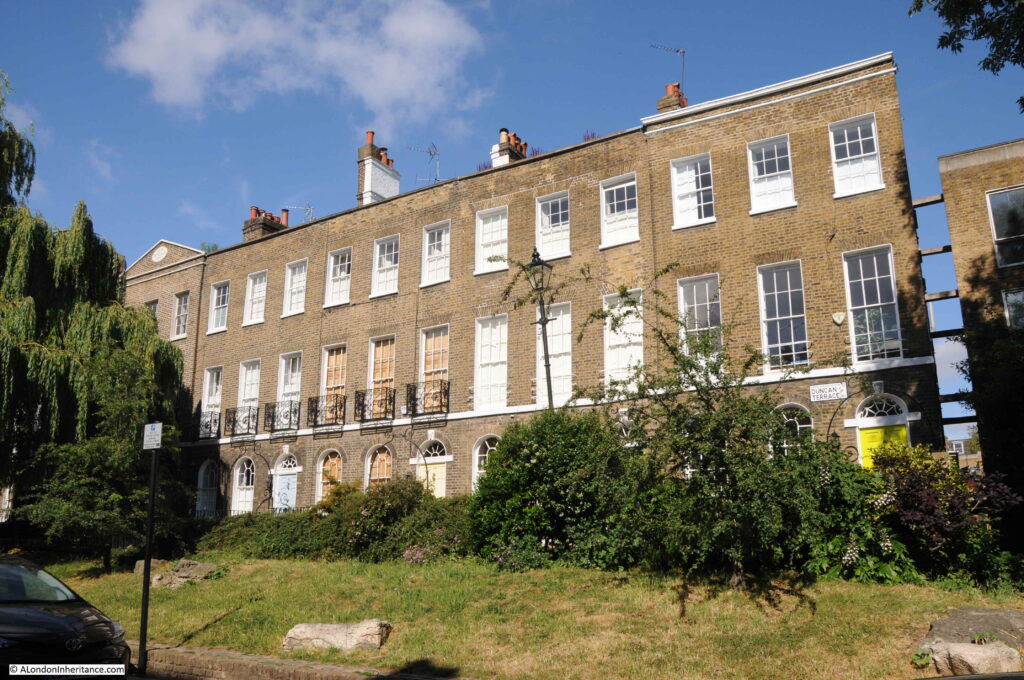
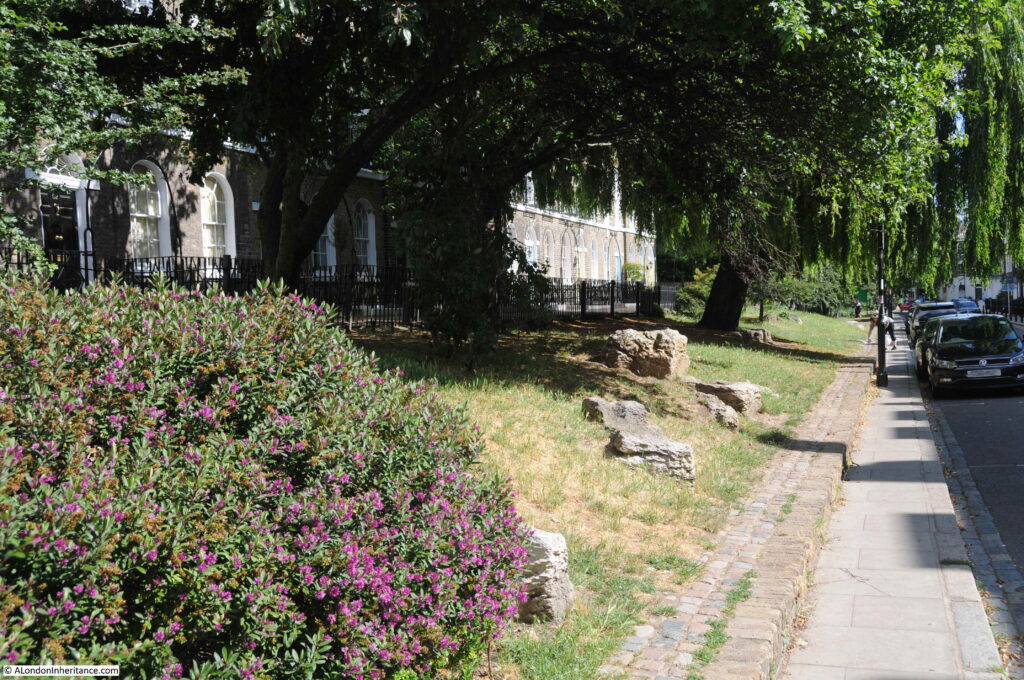
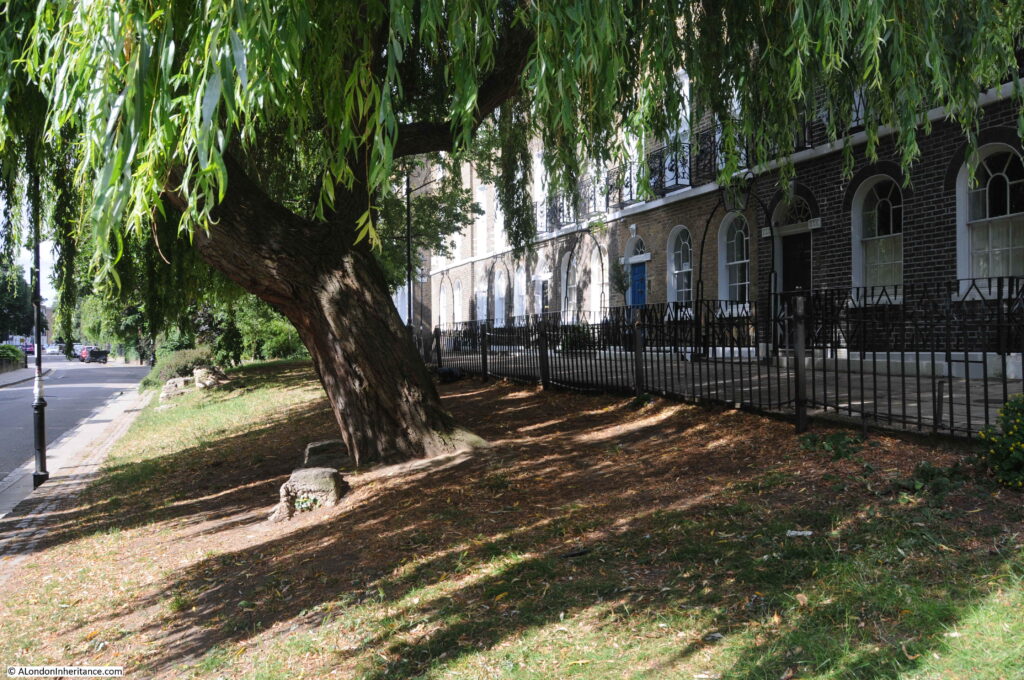


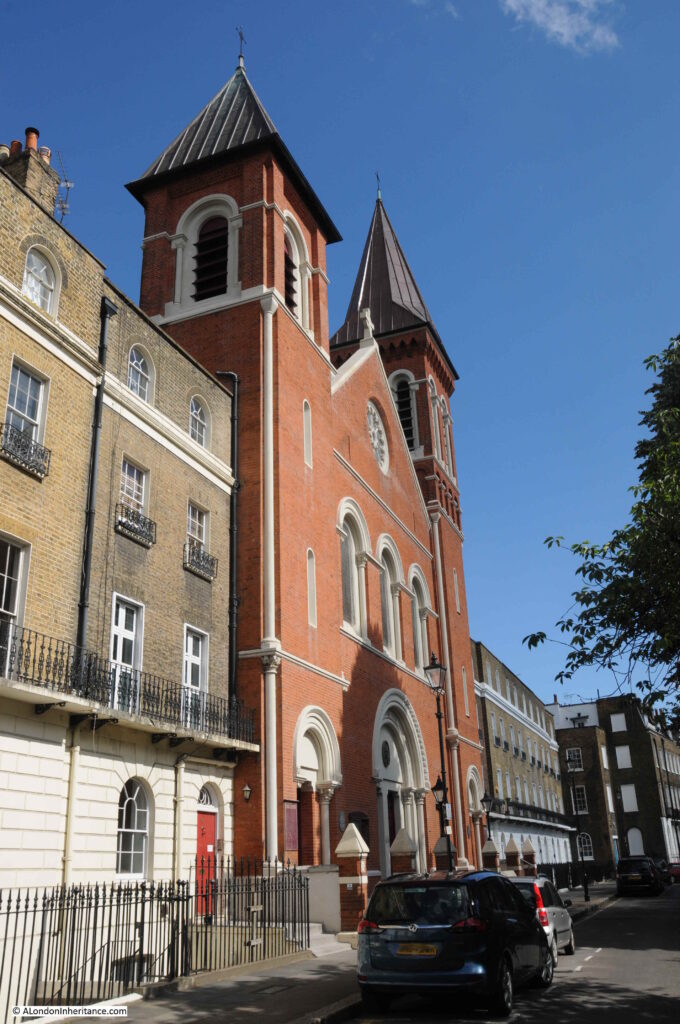
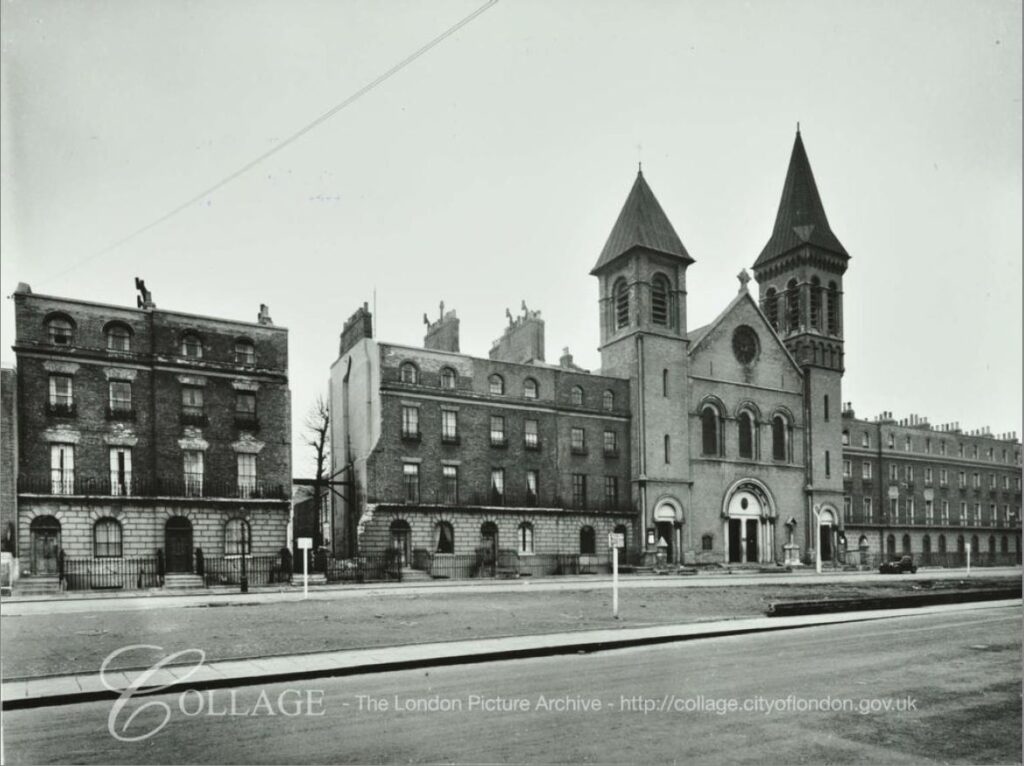





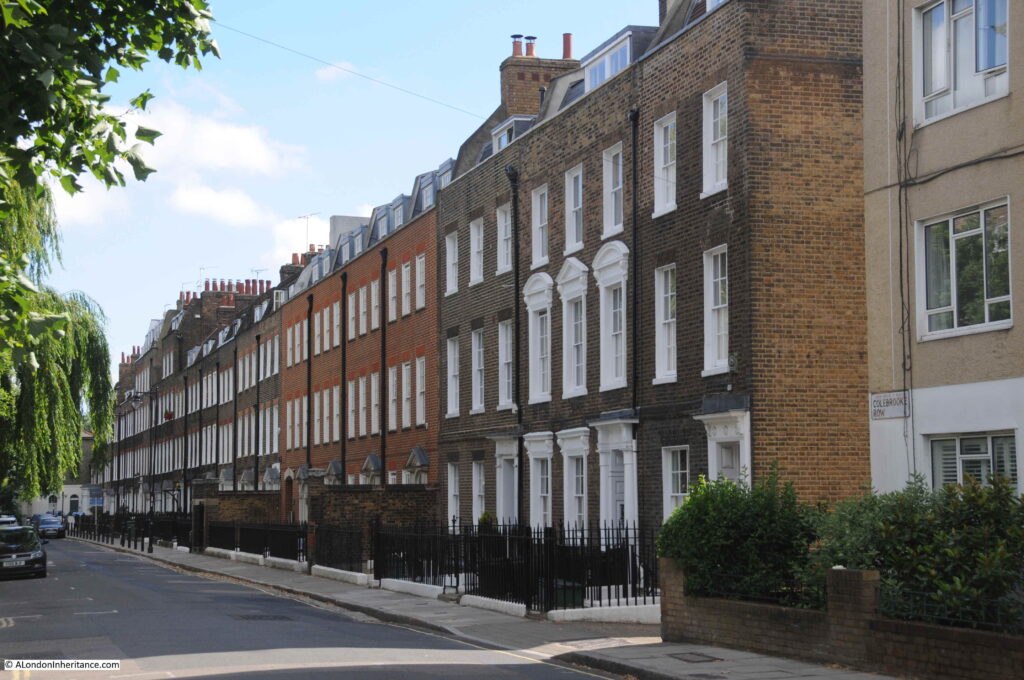
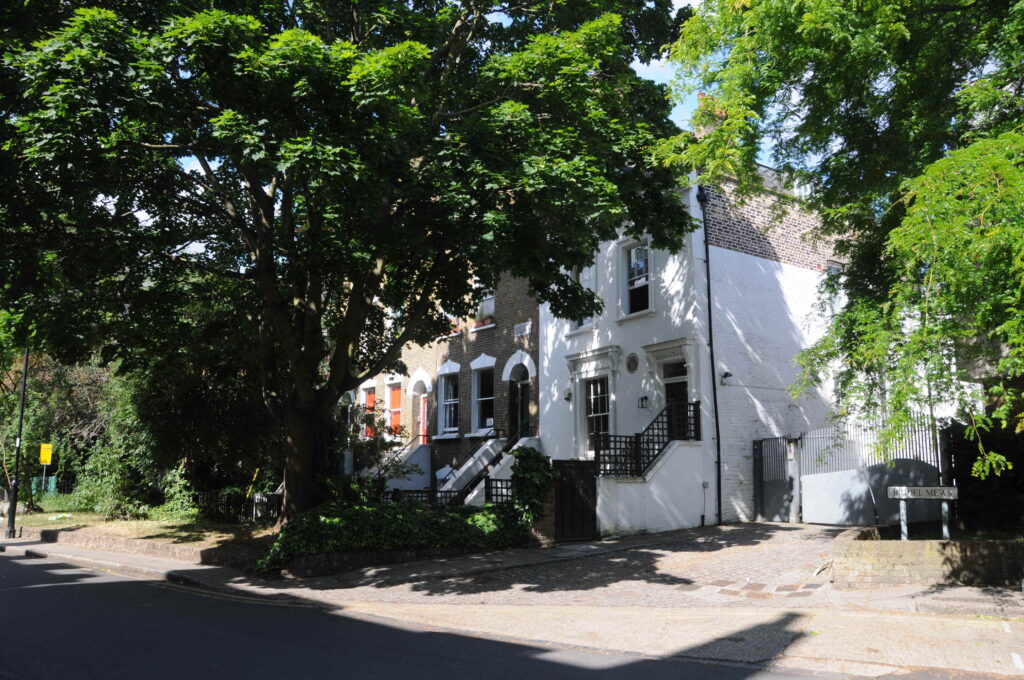
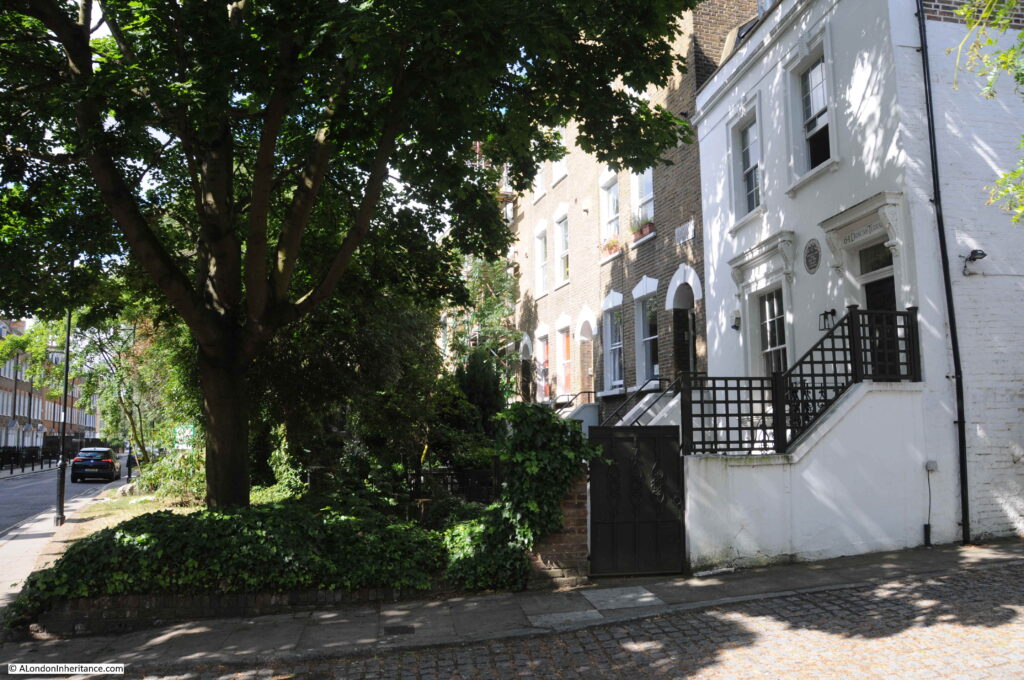
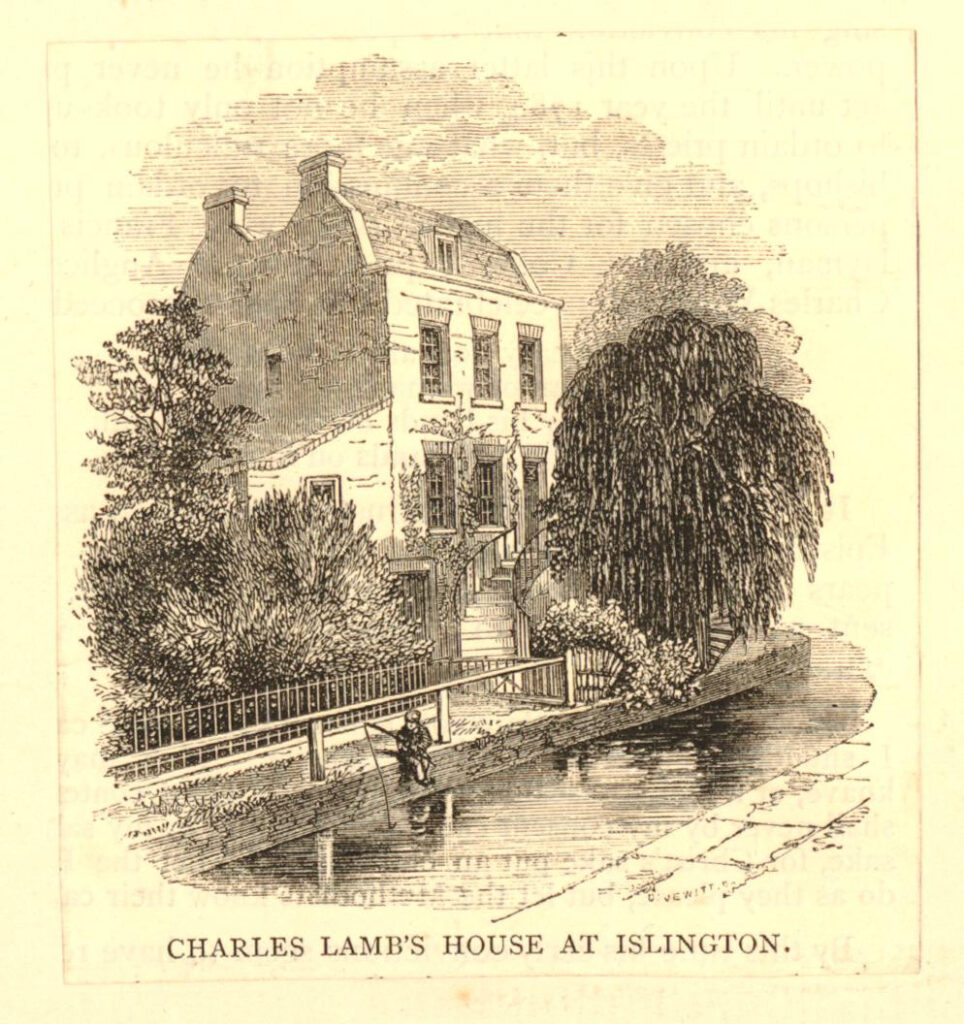

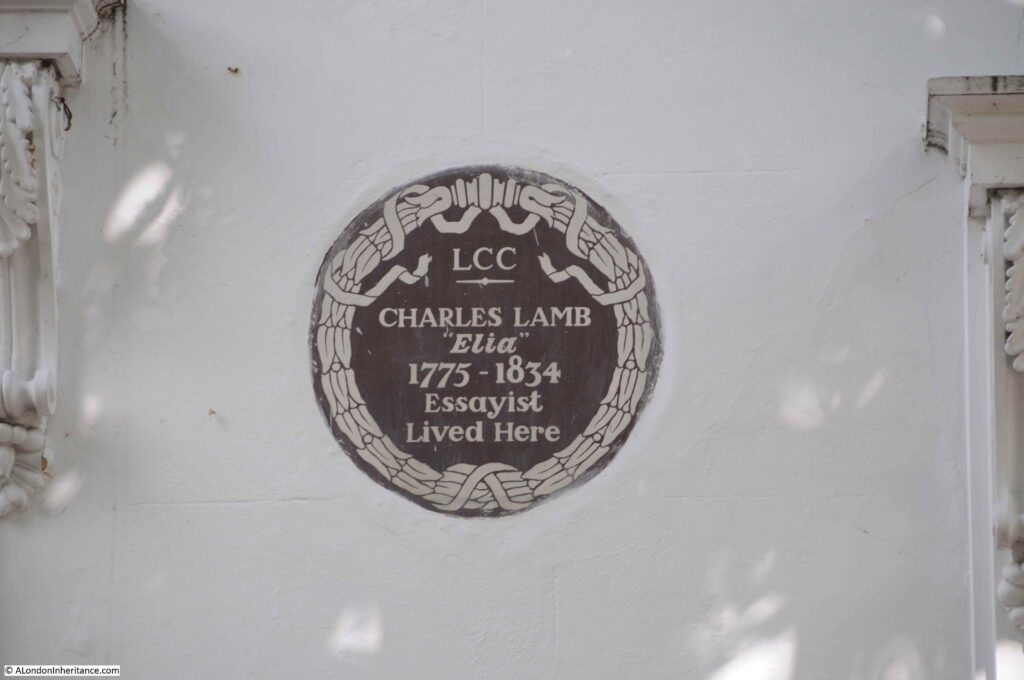
As always, a pleasure to read. Many thanks.
It is a very attractive part of town.
Simon.
I was born and raised on Duncan Terrace in the 1960’s, next to the bombed out house in your photo between the church and the courthouse. Good times despite the lack of facilities in the house (1 shared toilet for 5 families and no bath). I remember the course of the New River was good hunting ground for frogs and tadpoles as the landscaping of the ‘park’ included a few shallow ponds. At that time also the actor William Roache (of Coronation Street fame) occupied a house on Colebrooke Row, just a little north of Charles Lamb’s cottage. The plaque to Charles Lamb is not the only reminder of his time there, Elia Street leads off from Colebrooke Row to the south of the Regent’s Canal. How times change! Our rented house, where my father was paid 1400 pounds to vacate in 1970 was renovated and sold for a multi-million pound price some years later!
And now heartland of chattering classes and movers, shakers, makers and breakers, until recently Boris Johnson lived in the house adjacent to entrance to the canal footpath.
Dear author
Another well researched article a very important area
My uncle George cranwell rebuilt many of the old houses after the war In the area from reclaimed bricks that’s why they look so original
Colebrooke cotage in1842 was the residence of mr John Webb
He produced soda_water from a well in the rear garden a good read is s lewis Junior history of Islington. Ps author was your father a police officer
Thanks. I always take time to stopand read your posts. It’s worth adding that a few of the buildings in the corner opposite Charles’s house still remain from that time and would also overlooked the river. There are illustrations availble but I don’t have them to hand.
Fascinating as always.
Another fascinating article, thank you.
Thank you for another very interesting column. Epecially in these days of limited travel, it’s good to see and learn about a part of town I haven’t been able to visit in many months!
Your excellent and interesting article brought back to me many walks I took there from 2013 onwards with young asylum seekers, mainly from Afghanistan and Vietnam. I would go with them individually to the Islington Law Centre on nearby Devonia Road (next to St. Peter’s Church), where the brilliant solicitors there, some of whom are specialists in working with vulnerable young people, fought the long and tortuous fight against the Home Office (usually via the courts) in order for the young individuals to eventually be granted the safety and stability that comes with refugee status, a process that often takes years.
Many times I walked along the streets you explore with a young person so that they could relax a bit and come back to themselves after discussing difficult things. Now I understand why that area offers such a sense of peacefulness.
Thank you for movingly bringing this history into our time.
What wonderful History my Mum lived here for many years and worked at 46 Duncan Terrace at the time it belonged to the Marist Brothers she also worked at 40 Duncan Terrace which was run by the Sisters of the cross and passion it was also a hostel for women. My Mum has vascular Dementia now but you have brought her alive this afternoon with such wonderful memories,thank you so much.
Hi Maria…..I was stunned to read your note about 46 Duncan Terrace…. my Dad was a Marist Brother and left the property on 19th August 1948 to sail to ceylon as a missionary, to a teaching post. I know very little else about him as he died on my 2nd bithday in 1957..
Many thanks for another well researched and beautifully photographed insight. It is a street I walk often as it is near Cass Art, so I shall look at it again soon, but with fresh eyes. As commented already, there is a road called Elia Street, where there is to be found an excellent pub, The Charles Lamb, which we hope survives the lockdown.
When living and renting (a bedsit) in Islington in the early 1970`s I would look at all the old run down houses and wish I could afford to buy one. On a probationary teacher`s salary of 1,100 GBP a year they were unaffordable then, even in their run down ( probably multi occupied) state .
Even more out of reach for the like of teachers now !!
Thank you for the history.
Thanks. I enjoyed this installment. I have enjoyed walking through this area, both north through Islington and also along the Regent’s Canal. The facades on Charlton Place are especially lovely.
Farther up the Essex Road off Canonbury Rd. the New River emerges into daylight and runs through a narrow course having a footpath alongside for a 10-minute stroll up to St. Paul’s Road. I vaguely recall one of your earlier posts perhaps mentioning this.
Lyricist/Bohemian Fran Landesman (The Ballad of the Sad Young Men; Spring Can Really Hang You Up The Most) lived, quite colourfully, with her husband, publisher Jay, at 6 (I believe) Duncan Terrace for many years.
Glad to see you are out and about again! My great-grandparents lived in Vincent Terrace, alongside Regent’s Canal, somewhere else which has changed in fortunes drastically since they lived there in the 1920s. I had just stared exploring this area when Covid-19 struck, and am looking forward to returning when it seems sensible.
Really interesting
I went to the school connected to the church.
I now know the history of the street.
In the mid 80’s used to live at 35 Colebrook Row, on the first floor of the house shown in your photo, second from the right in the terrace of Georgian houses.
It was built in about 1790, and if I remember right, the houses on either side were built by the same builder at the same time. The white painted stucco pediments and window surrounds which differentiate it from the neighbouring houses were a later – early 19C ? – alteration.
Also…The four houses in a more red coloured brick on Colebrook Row, on the right handside of the photo are reproductions. When I lived there in the 80s there was a gap in the terrace here – most likely because of bomb damage. There was a brick wall to a school playground.
So happy to see you footloose once more, David, & not just for the selfish reason that we get fresh posts with our Sunday morning tea 🙂 I’m sure easing out of lockdown releases endorphins, but please please stay safe.
I have vivid memories of Duncan Terrace from 1969: I did my first practice teaching stint at the primary school on Duncan Street, walking there from City Road. Thanks to the ticket seller at Baker Street station, I’ve always remembered my first day commuting to Islington. At the booth, I asked for “a return ticket to Angel.” “Angel?” responded the incredulous clerk in what I recall as a rising Cockney accent: “What you want to go there for?” At the time, the station was served by incredibly unreliable lifts, featured heavily in Molly Dineen’s 1989 documentary, “Heart of the Angel.”
Very interesting and enjoyable read.
I’ve just discovered this “London Inheritance” blog and I think it’s wonderful! Thanks for all your hard work and fascinating insights – I’ve signed up for email posts so I’m looking forward to getting those too. I live fairly close to Duncan Terrace in Cloudesley Square and I maintain a website at http://www.cloudesleyassociation.org which also covers local history but on a much smaller scale than yours. You should come and visit us some time and do one of your terrific pieces!
Nick
Charles Lamb also has a school named after him in nearby Popham Street which I went to when I first started school in the mid 1950s .
What amazing history My mumhad lived here for manyyears and she worked at 40Duncan Terrace at the time it was run by theSisters of the Cross and Passion and was a hostel for women,my mum also worked at 46 Duncan Terrace she was a cook there for many years and it belonged to the Marist Brothers. My Mum now has vascular Dementia but she came aluve this afternoon with memories galoreconing back.
Nice article.
I’m writing this from Duncan Terrace; my mother’s house which she and my late father bought in 1960 when the banks were very reluctant to give mortgages for such places. I am reliably informed that we’re the fourth family to live in the house since it was built.
I’ve known the terrace since I was brought back form the maternity ward at the Royal Free, Liverpool Road in 1966. The Angel has changed a bit since then.
So interesting. I was a student at City and East London College from ~Sept 1979 to Summer 1981 and for 6/12 after that worked in London and during all that time I was lucky that my parents supported me at the hostel on Duncan Terrace run by The Sisters of The Cross and Passion next to St John’s Church.
During that time my experience of The Sisters and also The Marist Brothers next door was positive. The hostel was run in the main by Sr Josephine – from ?Killarney, a tough but kind and supportive cookie!! I remember a young nun who was also a Consultant at St Barts I think. The hostel hosted an international range of us girls/women, a few with a range of needs. I met good friends through St John’s Church (N+T and S.B. you know who you are !) and through College plus the then Monseigneur Bruce Kent AND I believe I had the chance to meet the young Spandau Ballet Band ( ?rehearsed on Duncan Terrace in a basement at The Angel end ) but I DECLINED !!!!! A couple of famous people attended various functions at the church community centre.
As an 18yr old I had no understanding of the privilege connected with even ‘renting’ to live in The Angel area nor of the potential the area would continue to achieve. Happy days. I was looked after. Thank you.